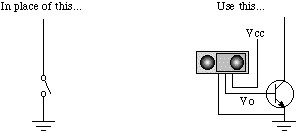|
|
BEAM Pieces is a BEAM Reference Library site.
Proximity sensors
Getting close...
Proximity sensors currently come in four flavors: IR (InfraRed), acoustic, capacitive, and inductive.
Infrared proximity sensors
Infrared proximity sensors work by sending out a beam of
IR light, and then computing the distance to any nearby
objects from characteristics of the returned (reflected)
signal. There are a number of ways to do this, each with its
own advantages and disadvantages:
Reflected IR strength
You could build a simple IR proximity sensor out of essentially just an IR LED and IR photodiode. This simple sensor, though, would be prey to background light (i.e., your IR "receiver" would be responding to naturally present IR as well as reflected IR).Modulated IR signal
A better solution would be to modulate your transmitted IR (i.e., to send out a rapidly-varying IR signal), and then have the receive circuitry only respond to the level of the received, matching, modulated IR signal (i.e., to ignore the DC component of the received signal, and only trigger off the AC component). This method, though, is still at the mercy of the characteristics (in particular, IR reflectance) of the obstacle you're trying to sense.Triangulation
The best way to use IR to sense an obstacle is to sense the angle at which the reflected IR is returned to your sensor. By use of a bit of trigonometry, you can then compute distance, knowing the location of your transmit and receive elements. Needless to say, this isn't a simple sensor to build yourself.
You're probably money ahead by just buying an IR proximity sensor with this logic built in. One I particularly like is the Sharp GP2D15 IR Ranger. It has a built-in detection range of 24 cm (this keeps its cost, and the complexity of your interface circuitry down), is reasonably priced, and is available from Acroname. Acroname also has an interesting article covering the operation and utilization of all the impressive Sharp IR sensors here.
The GP2D15 interface is 3-wire with power, ground and the output voltage (the sensor outputs Vcc when it sees something at 24 cm distance); it requires 4.5 - 5.5 V power for operation, and eats about 50 mA of current as long as it is powered. So its advantages are (1) its simple interface, and (2) easy, reliable sensing of obstacles at a distance. Its disadvantages are (1) its requirement for 5 V power, and (2) its requirement for 50 mA of current regardless of whether anything is being sensed (neither of these recommend this sensor for solar-powered 'bots).
If your BEAMbot's circuitry has provision for a "touch-switch" contact sensor, the GP2D15 can easily be used instead. If the circuit uses ground-referenced tactile sensors, just an NPN transistor is needed to enable this substitution:
 |
If your circuit has +V-referenced tactile sensors, use a PNP transistor to adapt a GP2D15 to replace each tactile sensor. For circuits with tactile switches connected between active parts of the circuit, you can use 4066-type analog gates (since this is a low-current application).
Acoustic proximity sensors
One oft-used method (at least on larger, pricier 'bots)
of avoiding hazards is via sonar ranging. Here, acoustic
signals ("ping"s) are sent out, with the time of echo return
being a measure of distance to an obstacle. This does,
unfortunately, require fairly accurate timing circuitry
-- so acoustic sensors really require a processor of some
sort to drive them. Also note that acoustic sensing
essentially requires the use of commercial sensors, there's
no real way to "homebrew" something from scratch.
The most common acoustic proximity sensor is the kind used in polaroid cameras. For details on these, I'll refer you to the Acroname site's "Polaroid Sonar Ranging Primer."
There's now also a "new kid on the block" -- the Devantech SRF04 UltraSonic Ranger. Acroname sells it (see their page on it here), and "Tech Geek" has a review on it here. This guy costs about twice what the Sharp IR sensors cost, but has a much wider range of sensing; it costs far less than the Polaroid acoustic rangers, is easier to interface, and draws less power.
Capacitive proximity sensors
Your 'bot can also sense its distance to objects by
detecting changes in capacitance around it. When power is
applied to the sensor, an electrostatic field is generated
and reacts to changes in capacitance cause by the presence
of a target. The main disadvantage to this sensor (often
called a capaciflector) is that its usefulness is dependent
on properties of the obstacles it is sensing (namely, their
dialectric constant). The higher the dielectric constant
(say, water), the more sensitive a capacitive sensor is to
that target. The sensing distance depends on the dielectric
constant of the target and the surface areas of the probe
and the target.
I go into more depth on this interesting sensor elsewhere.
Inductive proximity sensors
Another method for sensing distance to objects is
through the use of induced magnetic fields. The primary
problem with this method is that it is largely confined to
sensing metallic objects.
|
|
|
There's a page on using a Sharp GP1U5 IR
detector (for high-frequency modulated IR signals)
with a CPU-driven robot here. |
|
|
||
|
|
This page was last updated on |
|